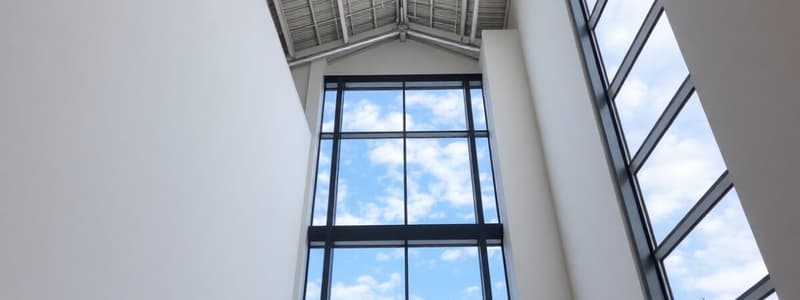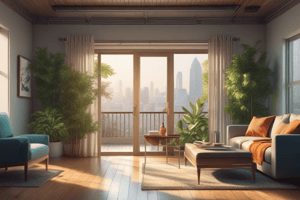Podcast
Questions and Answers
What does the air temperature refer to?
What does the air temperature refer to?
- The average temperature outside.
- The average temperature of the air inside a room. (correct)
- The temperature at which water freezes.
- The maximum temperature in a day.
What does Mean Radiant Temperature (MRT) represent?
What does Mean Radiant Temperature (MRT) represent?
- The average effect of radiation from surrounding surfaces inside a space. (correct)
- The highest temperature recorded in a room.
- The difference in temperature between the ceiling and the floor.
- The temperature measured by external weather stations.
Why is it important to measure air temperature in a room?
Why is it important to measure air temperature in a room?
- To analyze how radiation affects comfort levels.
- To determine how much insulation is needed.
- To assess heating efficiency and control HVAC systems. (correct)
- To predict outdoor weather changes.
Which factor influences the way air temperature is experienced by individuals?
Which factor influences the way air temperature is experienced by individuals?
What is not included in the definition of air temperature?
What is not included in the definition of air temperature?
What does relative humidity (RH) represent?
What does relative humidity (RH) represent?
How is sound typically measured?
How is sound typically measured?
What primarily causes sound?
What primarily causes sound?
Which statement about relative humidity is incorrect?
Which statement about relative humidity is incorrect?
What is the significance of measuring sound pressure levels?
What is the significance of measuring sound pressure levels?
What is a significant factor that can lead to respiratory problems in a poor indoor environment?
What is a significant factor that can lead to respiratory problems in a poor indoor environment?
How can natural lighting and ventilation impact health?
How can natural lighting and ventilation impact health?
What is an essential aspect of maintaining a healthy indoor environment?
What is an essential aspect of maintaining a healthy indoor environment?
Which health issue is most directly linked to poor indoor air quality?
Which health issue is most directly linked to poor indoor air quality?
What is one benefit of thermal comfort in buildings?
What is one benefit of thermal comfort in buildings?
Why is access to clean water important in buildings?
Why is access to clean water important in buildings?
What is the role of sustainable building designs in indoor health?
What is the role of sustainable building designs in indoor health?
What might excessive noise in an indoor environment lead to?
What might excessive noise in an indoor environment lead to?
Which aspect does NOT contribute to the pleasantness of the indoor environment?
Which aspect does NOT contribute to the pleasantness of the indoor environment?
What can result from a failure to address indoor environmental problems effectively?
What can result from a failure to address indoor environmental problems effectively?
What is a key factor when aiming to create a pleasant indoor environment?
What is a key factor when aiming to create a pleasant indoor environment?
Which of the following effects is enhanced by a good indoor environment?
Which of the following effects is enhanced by a good indoor environment?
What is a potential negative consequence of poor indoor climate management?
What is a potential negative consequence of poor indoor climate management?
Which component is part of the indoor climate?
Which component is part of the indoor climate?
What does the UN SDG Goal 3 focus on?
What does the UN SDG Goal 3 focus on?
To maintain a healthy indoor environment, attention should be on the building's life cycle. Which stage is NOT part of this cycle?
To maintain a healthy indoor environment, attention should be on the building's life cycle. Which stage is NOT part of this cycle?
What is the primary purpose of ventilation in a building?
What is the primary purpose of ventilation in a building?
Which factor does NOT affect the indoor climate of a sustainable building?
Which factor does NOT affect the indoor climate of a sustainable building?
How does excessive sound exposure affect a building's occupants?
How does excessive sound exposure affect a building's occupants?
What two primary components contribute to indoor lighting quality?
What two primary components contribute to indoor lighting quality?
What is the significance of air movement in a building?
What is the significance of air movement in a building?
What indoor condition can result from poor quality lighting?
What indoor condition can result from poor quality lighting?
What is a key reason for pursuing sustainable buildings in relation to occupants' health?
What is a key reason for pursuing sustainable buildings in relation to occupants' health?
Which instrument is most likely used to measure air movement?
Which instrument is most likely used to measure air movement?
Flashcards
Indoor Environment
Indoor Environment
The physical space inside a building, including the air quality, thermal comfort, acoustics, and lighting.
Indoor Climate
Indoor Climate
The environmental conditions inside a building, encompassing air quality, temperature, humidity, acoustics, and lighting.
Air Quality
Air Quality
The condition of the air inside a building, considering factors like ventilation and air movement.
Thermal Conditions
Thermal Conditions
Signup and view all the flashcards
Acoustic Conditions
Acoustic Conditions
Signup and view all the flashcards
Lighting Conditions
Lighting Conditions
Signup and view all the flashcards
Pleasant Indoor Environment
Pleasant Indoor Environment
Signup and view all the flashcards
UN SDG 3
UN SDG 3
Signup and view all the flashcards
Time Spent Indoors
Time Spent Indoors
Signup and view all the flashcards
Indoor Environment Impact
Indoor Environment Impact
Signup and view all the flashcards
Health Benefits of a Good Indoor Environment
Health Benefits of a Good Indoor Environment
Signup and view all the flashcards
Indoor Air Quality Threats
Indoor Air Quality Threats
Signup and view all the flashcards
Importance of Lighting and Ventilation
Importance of Lighting and Ventilation
Signup and view all the flashcards
Thermal Comfort for Health
Thermal Comfort for Health
Signup and view all the flashcards
Noise Reduction for Well-being
Noise Reduction for Well-being
Signup and view all the flashcards
Access to Clean Water
Access to Clean Water
Signup and view all the flashcards
Ventilation
Ventilation
Signup and view all the flashcards
Air Change Rate
Air Change Rate
Signup and view all the flashcards
Air Movement
Air Movement
Signup and view all the flashcards
Hot-Wire Anemometer
Hot-Wire Anemometer
Signup and view all the flashcards
Digital Thermometer
Digital Thermometer
Signup and view all the flashcards
Air Temperature
Air Temperature
Signup and view all the flashcards
Mean Radiant Temperature (MRT)
Mean Radiant Temperature (MRT)
Signup and view all the flashcards
What is the difference between air temperature and MRT?
What is the difference between air temperature and MRT?
Signup and view all the flashcards
How does MRT impact comfort?
How does MRT impact comfort?
Signup and view all the flashcards
How does MRT affect building design?
How does MRT affect building design?
Signup and view all the flashcards
Relative Humidity (RH)
Relative Humidity (RH)
Signup and view all the flashcards
How is RH measured?
How is RH measured?
Signup and view all the flashcards
Sound Level
Sound Level
Signup and view all the flashcards
What is sound?
What is sound?
Signup and view all the flashcards
Sound Pressure Level (SPL)
Sound Pressure Level (SPL)
Signup and view all the flashcards
Study Notes
Internal Environment of Buildings
- Buildings provide a space for occupants to work, relax, or rest.
- Indoor environments should be pleasant and comfortable.
- Indoor climate includes air quality, thermal conditions, acoustic conditions, and lighting conditions.
- Outdoor environment affects buildings with natural ventilation.
- Proper design & use of materials ensure comfortable indoor environments.
- Good indoor environments improve occupant health, comfort, and satisfaction.
Necessity of Pleasant Indoor Environments
- Occupants spend most of their time indoors.
- Indoor climate is crucial for well-being, productivity, and health.
- Indoor air quality, temperature, humidity, sound levels, and lighting levels all impact the indoor environment.
UN SDG 3: Good Health and Well-being
- Goal 3 focuses on healthy lives and well-being for all.
- People spend a significant portion of their time indoors.
- Indoor environments greatly affect people's health and well-being.
- Proper indoor air quality, lighting, temperature, and noise control can positively impact physical and mental well-being.
- Poor indoor air quality can cause respiratory issues, allergies, or cardiovascular diseases.
Factors Affecting Indoor Climate
- Ventilation: Involves providing fresh air and removing stale air, which is vital for maintaining good indoor air quality.
- Thermal Conditions: Human bodies need to lose heat to the environment to maintain a constant temperature; the surrounding air's temperature influences this heat exchange.
- Acoustic Conditions: High sound levels can negatively impact occupants.
- Lighting Conditions: Natural and artificial lighting affect occupant well-being.
Instruments Used to Determine Factors
- Air Movement: Measured using hot wire anemometers or rotating vane anemometers.
- Air Temperature: Measured with digital thermometers.
- Mean Radiant Temperature (MRT): Measured using globe thermometers that show the average effect of radiation from surrounding surfaces.
- Relative Humidity (RH): Measured with whirling hygrometers.
- Sound Level: Measured using sound level meters.
- Lighting Level: Measured using lux meters.
Studying That Suits You
Use AI to generate personalized quizzes and flashcards to suit your learning preferences.





